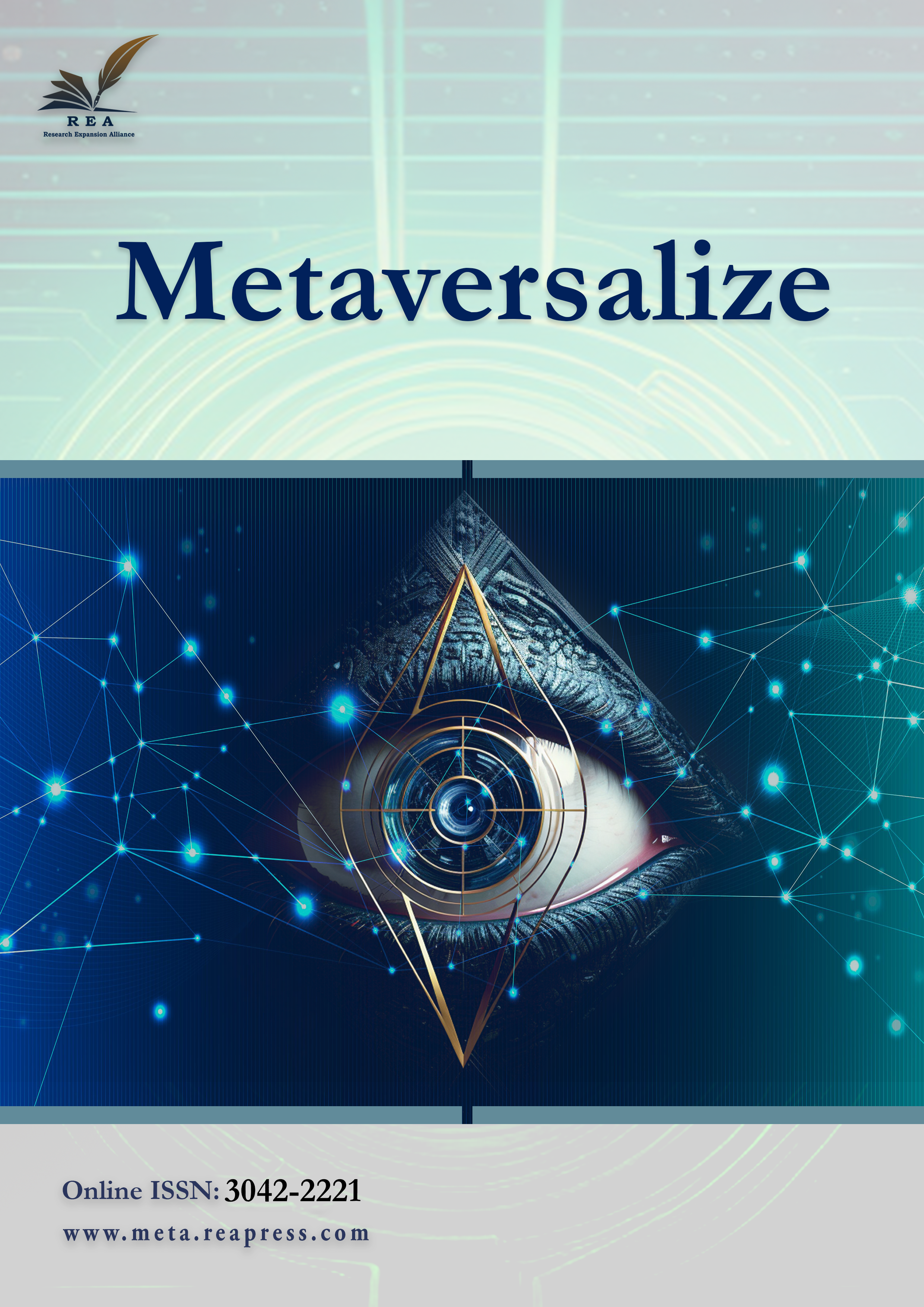A systematic review of Metaverse environment
Abstract
The rise of the metaverse, a blend of virtual and augmented realities, opens vast possibilities for social engagement, economic transactions, and digital innovation. However, establishing a reliable metaverse involves significant technical and ethical hurdles. From a technical perspective, creating the metaverse necessitates a robust infrastructure, including high-speed internet, advanced hardware, and scalable platforms capable of supporting many simultaneous users. Key challenges include ensuring interoperability among various systems and maintaining cybersecurity to protect user data and privacy. On the ethical front, the metaverse must tackle issues related to digital identity, inclusivity, and equitable access, striving to bridge digital divides and ensure the representation of diverse demographics. Furthermore, there is a need to develop measures to combat misinformation, harassment, and digital addiction, which requires robust governance frameworks. This paper delves into these complex challenges, advocating for a multi-stakeholder approach that brings together policymakers, technologists, and ethicists to establish comprehensive standards and regulations. By addressing both the technical and ethical aspects, the objective is to create a metaverse that is secure, inclusive, and advantageous for all users.
Keywords:
Metaverse, Trust, Privacy, Security, EthicsReferences
- [1] Moneta, A. (2020). Architecture, heritage, and the metaverse. Traditional dwellings and settlements review, 32(1), 37–49. https://www.jstor.org/stable/27074915
- [2] Díaz, J. E. M., Saldaña, C. A. D., & Avila, C. A. R. (2020). Virtual world as a resource for hybrid education. International journal of emerging technologies in learning, 15(15), 94–109. https://doi.org/10.3991/ijet.v15i15.13025
- [3] Wang, Y., Su, Z., Zhang, N., Xing, R., Liu, D., Luan, T. H., & Shen, X. (2023). A survey on metaverse: Fundamentals, security, and privacy. IEEE communications surveys and tutorials, 25(1), 319–352. https://doi.org/10.1109/COMST.2022.3202047
- [4] Duan, H., Li, J., Fan, S., Lin, Z., Wu, X., & Cai, W. (2021). Metaverse for social good: A university campus prototype [presentation]. Proceedings of the 29th ACM international conference on multimedia (pp. 153–161). https://doi.org/10.1145/3474085.3479238
- [5] Park, S. M., & Kim, Y. G. (2022). A metaverse: Taxonomy, components, applications, and open challenges. IEEE access, 10, 4209–4251. https://doi.org/10.1109/ACCESS.2021.3140175
- [6] Narin, N. G. (2021). A content analysis of the metaverse articles. Journal of metaverse, 1(1), 17–24. https://dergipark.org.tr/en/pub/jmv/issue/67581/1051382
- [7] Kraus, S., Kanbach, D. K., Krysta, P. M., Steinhoff, M. M., & Tomini, N. (2022). Facebook and the creation of the metaverse: Radical business model innovation or incremental transformation? International journal of entrepreneurial behaviour and research, 28(9), 52–77. https://doi.org/10.1108/IJEBR-12-2021-0984
- [8] Toreini, E., Aitken, M., Coopamootoo, K., Elliott, K., Zelaya, C. G., & van Moorsel, A. (2020). The relationship between trust in AI and trustworthy machine learning technologies [presentation]. FAT* 2020 - proceedings of the 2020 conference on fairness, accountability, and transparency (pp. 272–283). https://doi.org/10.1145/3351095.3372834
- [9] Guo, Y., Yu, T., Wu, J., Wang, Y., Wan, S., Zheng, J., … & Dai, Q. (2022). Artificial intelligence for metaverse: A framework. CAAI artificial intelligence research, 1(1), 54–67. https://doi.org/10.26599/air.2022.9150004
- [10] Jones, R. K., & Lee, D. N. (1981). Why two eyes are better than one: the two views of binocular vision. Journal of experimental psychology: Human perception and performance, 7(1), 30–40. https://doi.org/10.1037/0096-1523.7.1.30
- [11] Tunca, S., Sezen, B., & Wilk, V. (2023). An exploratory content and sentiment analysis of the guardian metaverse articles using leximancer and natural language processing. Journal of Big Data, 10(1), 82. https://doi.org/10.1186/s40537-023-00773-w
- [12] Hemp, P. (2006). Avatar-based marketing. Harvard business review, 84(6), 48–57. http://www.etchouse.com/mcma510/readings/hemp-2006.pdf
- [13] Kou, Y., & Gui, X. (2023). Harmful design in the metaverse and how to mitigate it: A case study of user-generated virtual worlds on roblox [presentation]. Proceedings of the 2023 acm designing interactive systems conference (pp. 175–188). https://doi.org/10.1145/3563657.3595960
- [14] Ponce, B. A., Menendez, M. E., Oladeji, L. O., Fryberger, C. T., & Dantuluri, P. K. (2014). Emerging technology in surgical education: combining real-time augmented reality and wearable computing devices. Orthopedics, 37(11), 751–757. https://doi.org/10.3928/01477447-20141023-05
- [15] El Faqir, Y., Arroyo, J., & Hassan, S. (2020). An overview of decentralized autonomous organizations on the blockchain [presentation]. Proceedings of the 16th international symposium on open collaboration (pp. 1–8). https://doi.org/10.1145/3412569.3412579
- [16] Chrétien-Ichikawa, S. (2022). Shanghai fashion and post-1990s youth through the Phygital Lens. In Creative industries and digital transformation in China (pp. 117–146). Springer. https://doi.org/10.1007/978-981-19-3049-2_6
- [17] Maeng, Y., Lee, C. C., & Yun, H. (2023). Understanding antecedents that affect customer evaluations of head-mounted display VR devices through text mining and deep neural network. Journal of theoretical and applied electronic commerce research, 18(3), 1238–1256. https://doi.org/10.3390/jtaer18030063
- [18] Huynh-The, T., Pham, Q. V., Pham, X. Q., Nguyen, T. T., Han, Z., & Kim, D. S. (2023). Artificial intelligence for the metaverse: A survey. Engineering applications of artificial intelligence, 117, 105581. https://doi.org/10.1016/j.engappai.2022.105581
- [19] Cheong, B. C. (2022). Avatars in the metaverse: Potential legal issues and remedies. International cybersecurity law review, 3(2), 467–494. https://doi.org/10.1365/s43439-022-00056-9
- [20] Yang, Q., Zhao, Y., Huang, H., Xiong, Z., Kang, J., & Zheng, Z. (2022). Fusing Blockchain and AI with metaverse: A survey. IEEE open journal of the computer society, 3, 122–136. https://doi.org/10.1109/OJCS.2022.3188249
- [21] Regner, F., Schweizer, A., & Urbach, N. (2019). NFTs in practice-non-fungible tokens as core component of a Blockchain-based event ticketing application [presentation]. 40th international conference on information systems, icis 2019 (pp. 1–17). https://www.fim-rc.de/Paperbibliothek/Veroeffentlicht/1045/wi-1045.pdf
- [22] Zhang, H., Lee, S., Lu, Y., Yu, X., & Lu, H. (2023). A survey on Big Data technologies and their applications to the metaverse: Past, current and future. Mathematics, 11(1), 96. https://doi.org/10.3390/math11010096
- [23] Tang, F., Chen, X., Zhao, M., & Kato, N. (2023). The roadmap of communication and networking in 6g for the metaverse. IEEE wireless communications, 30(4), 72–81. https://doi.org/10.1109/MWC.019.2100721
- [24] Kiong, L. V. (2022). Web3 made easy: A comprehensive guide to Web3: everything you need to know about web3, Blockchain, DeFi, Metaverse, NFT and GameFi. Liew Voon Kiong. https://l1nq.com/NCLkG
- [25] Adams, D. (2022). Virtual retail in the metaverse: Customer behavior analytics, extended reality technologies, and immersive visualization systems. Linguistic and philosophical investigations, 21(21), 73–88. https://doi.org/10.22381/lpi2120225.
- [26] Kshetri, N. (2022). Web 3.0 and the metaverse shaping organizations’ brand and product strategies. IT professional, 24(02), 11–15. https://doi.org/10.1109/MITP.2022.3157206
- [27] Wagner, R., & Cozmiuc, D. (2022). Extended reality in marketing—a multiple case study on internet of things platforms. Information, 13(6), 278. https://doi.org/10.3390/info13060278
- [28] McLean, G., & Wilson, A. (2019). Shopping in the digital world: Examining customer engagement through augmented reality mobile applications. Computers in human behavior, 101, 210–224. https://doi.org/10.1016/j.chb.2019.07.002
- [29] Drapkin, A. (2023). Metaverse companies: Who’s involved and who’s investing in 2023. https://tech.co/news/metaverse-companies-whos-involved-whos-investing
- [30] Dincelli, E., & Yayla, A. (2022). Immersive virtual reality in the age of the metaverse: A hybrid-narrative review based on the technology affordance perspective. Journal of strategic information systems, 31(2), 101717. https://doi.org/10.1016/j.jsis.2022.101717
- [31] Hennig-Thurau, T., Aliman, D. N., Herting, A. M., Cziehso, G. P., Linder, M., & Kübler, R. V. (2023). Social interactions in the metaverse: Framework, initial evidence, and research roadmap. Journal of the academy of marketing science, 51(4), 889–913. https://doi.org/10.1007/s11747-022-00908-0
- [32] Ong, T., Wilczewski, H., Paige, S. R., Soni, H., Welch, B. M., & Bunnell, B. E. (2021). Extended reality for enhanced telehealth during and beyond covid-19: Viewpoint. JMIR serious games, 9(3), e26520. https://doi.org/10.2196/26520
- [33] Khan, N., Muhammad, K., Hussain, T., Nasir, M., Munsif, M., Imran, A. S., & Sajjad, M. (2021). An adaptive game-based learning strategy for children road safety education and practice in virtual space. Sensors, 21(11), 3661. https://doi.org/10.3390/s21113661
- [34] Wiederhold, B. K., & Riva, G. (2022). Metaverse creates new opportunities in healthcare. Annual review of cybertherapy and telemedicine, 20, 3–7. https://psycnet.apa.org/record/2023-49082-001
- [35] Schumacher, P. (2022). The metaverse as opportunity for architecture and society: Design drivers, core competencies. Architectural intelligence, 1(1), 11. https://doi.org/10.1007/s44223-022-00010-z
- [36] Thomason, J. (2022). Metaverse, token economies, and non-communicable diseases. Global health journal, 6(3), 164–167. https://doi.org/10.1016/j.glohj.2022.07.001
- [37] Mourtzis, D., Angelopoulos, J., & Panopoulos, N. (2023). Blockchain integration in the era of industrial metaverse. Applied sciences, 13(3), 1353. https://doi.org/10.3390/app13031353
- [38] Hosain, T., Zaman, A., Abir, M. R., Akter, S., Mursalin, S., & Khan, S. S. (2024). Synchronizing object detection: Applications, advancements and existing challenges. IEEE access, 12, 54129–54167. https://doi.org/10.1109/ACCESS.2024.3388889
- [39] Hosain, M. T., Jim, J. R., Mridha, M. F., & Kabir, M. M. (2024). Explainable AI approaches in deep learning: Advancements, applications and challenges. Computers and electrical engineering, 117, 109246. https://doi.org/10.1016/j.compeleceng.2024.109246
- [40] Hosain, M. T., Anik, M. H., Rafi, S., Tabassum, R., Insia, K., & Siddiky, M. M. (2023). Path to gain functional transparency in artificial intelligence with meaningful explainability. Journal of metaverse, 3(2), 166–180. https://doi.org/10.57019/jmv.1306685
- [41] Hawblitzel, C., Howell, J., Lorch, J. R., Narayan, A., Parno, B., Zhang, D., & Zill, B. (2014). Ironclad apps:{End-to-End} security via automated {Full-System} verification [presentation]. 11th USENIX symposium on operating systems design and implementation (OSDI 14) (pp. 165–181). https://www.usenix.org/conference/osdi14
- [42] Koh, N., Li, Y., Li, Y., Xia, L., Beringer, L., Honoré, W., … & Zdancewic, S. (2019). From C to interaction trees: Specifying, verifying, and testing a networked server [presentation]. Proceedings of the 8th ACM SIGPLAN international conference on certified programs and proofs (pp. 234–248). https://doi.org/10.1145/3293880.3294106
- [43] Miron, M., Tolan, S., Gómez, E., & Castillo, C. (2021). Evaluating causes of algorithmic bias in juvenile criminal recidivism. Artificial intelligence and law, 29(2), 111–147. https://doi.org/10.1007/s10506-020-09268-y
- [44] Bhargavan, K., Delignat-Lavaud, A., Fournet, C., Kohlweiss, M., Pan, J., Protzenko, J., … & Zinzindohoué, J. K. (2017). Implementing and proving the TLS 1.3 record layer [presentation]. SP 2017-38th IEEE symposium on security and privacy (pp. 463–482). https://inria.hal.science/hal-01674096/
- [45] Rassmann, K. A. (2022). A goal, question, metric approach to coherent use integration within the devops lifecycle. https://drum.lib.umd.edu/handle/1903/29022
- [46] Jim, J. R., Hosain, M. T., Mridha, M. F., Kabir, M. M., & Shin, J. (2023). Towards trustworthy metaverse: Advancements and challenges. IEEE access, 11, 118318–118347. https://doi.org/10.1109/ACCESS.2023.3326258
- [47] Liddicoat, J., & Doria, A. (2011). Human rights and internet protocols : Comparing processes and principles. Retrieved july, 13, 1–13. https://www.internetsociety.org/wp-content/uploads/2017/08/Human20Rights20and20Internet20Protocols-20Comparing20Processes20and20Principles.pdf
- [48] Yellowlees, P. M., & Marks, S. (2007). Problematic internet use or internet addiction? Computers in human behavior, 23(3), 1447–1453. https://doi.org/10.1016/j.chb.2005.05.004
- [49] Chang, C. L., Hung, J. L., Tien, C. W., Tien, C. W., & Kuo, S. Y. (2020). Evaluating robustness of ai models against adversarial attacks [presentation]. Proceedings of the 1st ACM workshop on security and privacy on artificial intelligence (pp. 47–54). https://doi.org/10.1145/3385003.3410920
- [50] Bessen, J. E., Impink, S. M., Reichensperger, L., & Seamans, R. (2020). GDPR and the importance of data to AI startups. NYU stern school of business. https://papers.ssrn.com/sol3/papers.cfm?abstract_id=3576714
- [51] Wachter, S., & Mittelstadt, B. (2019). A right to reasonable inferences: Re-thinking data protection law in the age of Big Data and AI. Columbia business law review, 2019(2), 494–620. https://heinonline.org/HOL/LandingPage?handle=hein.journals/colb2019&div=15&id=&page=
- [52] Zhou, J., Chen, F., & Holzinger, A. (2022). Towards explainability for AI fairness. In XxAI - beyond explainable AI (Vol. 13200 LNAI, pp. 375–386). https://doi.org/ 10.1007/978-3-031-04083-2_18
- [53] Dwivedi, Y. K., Kshetri, N., Hughes, L., Rana, N. P., Baabdullah, A. M., Kar, A. K., … & Yan, M. (2023). Exploring the darkverse: A multi-perspective analysis of the negative societal impacts of the metaverse. Information systems frontiers, 25(5), 2071–2114. https://doi.org/10.1007/s10796-023-10400-x
- [54] Kshetri, N. (2022). Policy, ethical, social, and environmental considerations of Web3 and the metaverse. IT professional, 24(3), 4–8. https://doi.org/10.1109/MITP.2022.3178509
- [55] Langvardt, K. (2017). Regulating online content moderation. Geo. LJ, 106, 1353. https://heinonline.org/HOL/LandingPage?handle=hein.journals/glj106&div=39&id=&page=
- [56] Voigt, P., & dem Bussche, A. (2017). The eu general data protection regulation (GDPR). Springer. https://doi.org/10.1007/978-3-319-57959-7
- [57] Gorlini, C., Dixen, L., & Burelli, P. (2023). Investigating the uncanny valley phenomenon through the temporal dynamics of neural responses to virtual characters. 2023 IEEE conference on games (CoG) (pp. 1–8). IEEE. https://doi.org/10.1109/CoG57401.2023.10333130
- [58] Zhang, X., Min, G., Li, T., Ma, Z., Cao, X., & Wang, S. (2023). AI and Blockchain empowered metaverse for Web 3.0: Vision, architecture, and future directions. IEEE communications magazine, 61(8), 60–66. https://doi.org/10.1109/MCOM.004.2200473
- [59] Mahmoud, M., Rizou, S., Panayides, A. S., Kantartzis, N. V., Karagiannidis, G. K., Lazaridis, P. I., & Zaharis, Z. D. (2023). A survey on optimizing mobile delivery of 360° videos: Edge caching and multicasting. IEEE access, 11, 68925–68942. https://doi.org/10.1109/ACCESS.2023.3292335






